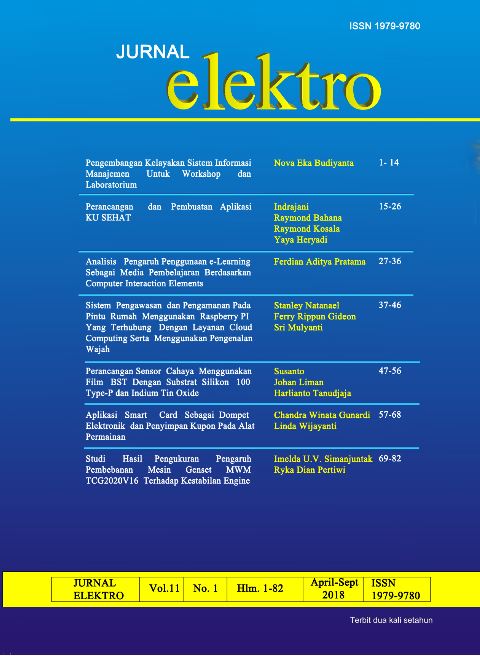PERANCANGAN SENSOR CAHAYA MENGGUNAKAN FILM BST DENGAN SUBSTRAT SILIKON 100 TYPE-P DAN INDIUM TIN OXIDE
Keywords:
BST, Silikon, ITO, CSD, Kubelka-Monk, Tauc PlotAbstract
ABSTRAK
Tujuan dari penelitian ini untuk mengetahui sifat-sifat optik dari film tipis BST (B0,5S0,5TiO3) dengan 2 substrat yang berbeda yaitu substrat Indium Tin Oxide (ITO) dan substrat Silikon 100 tipe-p. Proses ini menggunakan metode Chemical Solution Decomposition (CSD) dengan substrat ditetesi larutan BST dan mengalami spin coating dengan kecepatan 3000 rpm selama 30 detik. Proses annealing dengan suhu 850 oC untuk substrat Silikon 100 tipe-p dan 200 oC untuk substrat ITO. Pengujian sifat optik yaitu sifat reflekstansi dari film tipis. Dari hasil pengujian untuk 6 sampel untuk setiap substrat, film tipis substrat silikon memiliki reflekstansi maksimum pada panjang gelombang 430-440 nm dan reflektansi minimum pada panjang gelombang 360-380 nm, sedangkan film tipis substrat ITO memiliki reflekstansi maksimum pada panjang gelombang 280 nm dan reflekstansi minimum pada panjang gelombang 380 nm dan kestabilan reflekstansi terjadi pada panjang gelombang 460-830 nm. Dari hasil pengukuran menggunakan spektrometer, celah pita energi dapat ditentukan dengan metode Kubelka-Monk dengan menggunakan relasi Tauc Plot. Hasil pada sensor bersubstrat silikon dapat bekerja dengan mendeteksi pengaruh cahaya tampak dan cahaya ultraviolet sedangkan pada sensor bersubstrat ITO dapat bekerja dengan mendeteksi pengaruh cahaya tampak.
ABSTRACT
The purpose of this research is to know the optical properties of thinfilm BST (B0,5S0,5TiO3) with 2 different substrate of Indium Tin Oxide substrate (ITO) and p-type Silicon 100 substrate. This process uses Chemical Solution Decomposition (CSD) method which substrate is injected with BST and spin coating at 3000 rpm for 30 seconds. Followed by annealing process with temperature 850 oC for p-type 100 silicon substrate and for ITO substrate with temperature of 200 oC using Chemical Solution Decomposition (CSD) method. Testing of optical properties is the nature of the reflectance of the film. From the test results for 6 samples for each substrate, the silicon substrate filmisation has a maximum reflectance at the 430-440 nm wavelength and minimum reflectance at 360-380 nm wavelength, while ITO substrate filmization has maximum reflectance at 280 nm wavelength and minimum reflectivity at 380 nm wavelength and reflectivity stability occurs at 460-830 nm wavelength. From the results using a spectrometer, the energy band gap can be determined by Kubelka-Monk method using Tauc Plot relation. the results on the silicon substrate sensor can work by detecting light and ultraviolet light while on the ITO substrate sensor can work by detecting visible light.
References
[2] Faanzir dan Umar. 2013. Teknologi Proses Produksi Sensor Cahaya untuk Pengembangan Robotik Berbasis Teknologi Lapisan Tipis Bahan Ferroelektrik Barium Stronsium Titanat (Ba0,55Sr0,45TiO3). Jurnal Media Elektro.
[2] Hunter Lab. 2008. The Kubelka-Monk Theory and K/s. skripsi. Pdf.
[3] Liman, Johansah, dkk. 2015. Penumbuhan Film Tipis Ba0.5Sr0.5TiO3 di atas Substrat Si (100) Type-p dengan Metode Chemical Solution Deposition (CSD) dan Analisis Sifat Optik. to be publish in Prosiding LINOF 2015, Pusat Penelitian Fisika LIPI.
[4] Liman, Johansah, dkk. 2015. Uji Sifat Optik Film Tipis Ba0.55Sr0.45TiO3 di Atas Substrat Corning Glass 7059. Jurnal Fisika Indonesia.
[5] M. Sukumar, L. John Kennedy, J. Judith Vijaya, B. Al-Najar, M. Bououdina, Facile microwave assisted combustion synthesis, structural, optical and magnetic properties of La2- x Sr x CuO4 (0 = x =0.5) perovskite nanostructures. Journal of Magnetism and Magnetic Materials (2018).
[6] Novianty Keyza, Lubis, tony. 2012. Perancangan Prototipe Sistem Penerangan Otomatis Ruangan Berjendela Berdasarkan Intensitas Cahaya. Seminar Nasional Teknologi Informasi 2012. Universitas Tarumanegara Fakultas Teknologi Informasi.
[7] N. Fifere, A. Airinei, D. Timpu, A. Rotaru, L. Sacarescu, L. Ursu, New insights into structural and magnetic properties of Ce doped ZnO nanoparticles, Journal of Alloys and Compounds (2018).
[8] Nur Hilaluddin, Muhammad. 2011. PEMBUATAN SEL SURYA BERBASIS FILM FERROELEKTRIK BARIUM STRONTIUM TITANATE (Ba0,5Sr0,5TiO3). Institut Pertanian Bogor.
[9] R Estrada, N Djohan, D Pasole, M Dahrul, A Kurniawan, J Iskandar,H Hardhienata and Irzaman. The optical band gap of LiTaO3 and Nb2O5-doped LiTaO3. thin films based on Tauc Plot method to be applied on satellite, IOP Conf. Ser.: Earth Environ. Sci. 54 012092.
[10] Samiya Manzoor and Shahid Husain. 2018. In?uence of Zn doping on structural, optical and dielectric propertiesof LaFeO3. IOP Publishing. Department of Physics, Aligarh Muslim University, Aligarh 202002, India.
[11] Schrade, Matthias; Magraso, Anna; Galeckas, Augustinas; Finstad, Terje & Norby, Truls (2016). The Band Gap of BaPrO3 Studied by Optical and Electrical Methods. Journal of The American Ceramic Society.
[12] Syam, R. 2013. Dasar-dasar teknik sensor. Universitas Hasanuddin, Makassar.
[13] Bahan kuliah fisika,” semikonduktor”. Homepage Online. Available from
http://staff.uny.ac.id/sites/default/files/pendidikan/drs-sumarna-msi-meng/
bahan-kuliah-fisika-semikonduktor.pdf; internet; accessed 15 june 2017.
[14] Elektronika,” Teori dan penerapan”. Homepage Online. Available from http://staffnew.uny.ac.id/upload/131666733/pendidikan/Elektronika++Te-ori+dan+Penerapan-BAB1-sc.pdf; internet; accessed 15 june 2017.
[15] Gelombang Elektromagnetika,” Elektromagnet”. Homepage Online. Available from https://mohamadramdhani.staff.telkomuniversity.ac.id/files
/2015/09/2-Elektromagnetika-v1-bag-2.pdf; internet; accessed 15 june 2017.
[16] Info-elektro,” semikonduktor”. Homepage Online. Available from http:// www.info-elektro.com/2013/06/bahan-semikonduktor-ilmu-bahan-listrik.h tml; internet; accessed 15 june 2017.
[17] Polsri,” Sensor Cahaya”. Homepage Online. Available from http://eprints.polsri.ac.id/1128/3/BAB%20II.pdf; internet; accessed 15 june 2017.
[18] Sastra Kusuma Wijaya,” Semikonduktor”. Homepage Online. Available from http://staff.ui.ac.id/system/files/users/sastra.kusuma/material/05semi- kondutor.pdf; internet; accessed 19 june 2017.
[19] Zona Elektro,” Sensor Cahaya”. Homepage Online. Available from http://zonaelektro.net/sensor-cahaya/; internet; accessed 15 june 2017.



